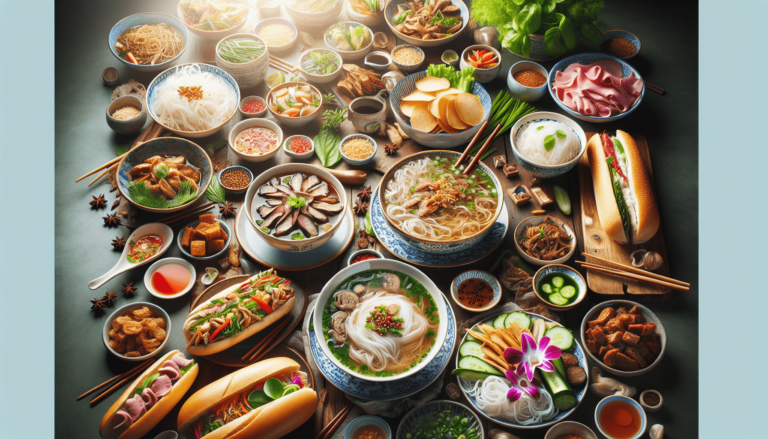Craving a hearty bowl of delicious Asian noodles, but unsure about which one is the healthier option? Look no further than the age-old debate of pho versus ramen. Both dishes are renowned for their rich flavors and comforting qualities, but when it comes to nutritional value, is one better than the other? In this article, we will explore the differences between pho and ramen, examining their ingredients and preparation methods to help you make a well-informed decision. So, whether you’re a pho fanatic or a ramen enthusiast, join us on this culinary journey as we uncover the answer to the question: is pho or ramen healthier?
Background Information on Pho
Pho is a traditional Vietnamese dish that has gained popularity worldwide for its delicious flavors and comforting qualities. This aromatic soup is a staple in Vietnamese cuisine and is often enjoyed as a main meal. Here is some background information on the history, origin, ingredients, and preparation of pho.
History and Origin of Pho
Pho originated in the early 20th century in northern Vietnam. It is believed to have been influenced by both Chinese and French culinary traditions. The dish evolved from previous Vietnamese noodle soups, but it was in Hanoi, the country’s capital, where it truly developed its unique identity.
Ingredients Commonly Used in Pho
The key components of pho include rice noodles, broth, and a variety of toppings. The broth is typically made by simmering beef bones, various spices, and herbs for several hours to achieve a rich and flavorful base. Common toppings include thinly sliced beef or chicken, bean sprouts, Thai basil, lime wedges, and chili peppers. Hoisin sauce and sriracha are often added to enhance the flavors according to personal preferences.
Typical Preparation and Serving Method of Pho
Traditional pho preparation involves meticulous attention to detail. The broth is simmered for hours to extract all the rich flavors and nutrients from the bones and spices. The rice noodles are cooked separately and then added to bowls along with the desired meat and toppings. The hot broth is then poured over the noodles and garnished with herbs and condiments. Pho is typically served with a side plate of fresh bean sprouts, Thai basil, lime wedges, and chili peppers, allowing diners to personalize their bowls according to their taste preferences.
Nutritional Content of Pho
When it comes to evaluating the nutritional content of pho, it is essential to consider the caloric content, macronutrient levels, vitamin and mineral content, as well as the sodium levels present in this popular Vietnamese dish.
Caloric Content
The caloric content of a bowl of pho can vary depending on the specific ingredients used and the portion sizes. On average, a bowl of pho can range from 350 to 450 calories. However, it’s important to note that this estimate may increase if additional condiments such as hoisin sauce or Sriracha are added.
Protein, Fat, and Carbohydrate Levels
Pho can provide a well-balanced mix of macronutrients. A typical serving of pho contains around 20 grams of protein, which primarily comes from the beef or chicken used in the dish. The fat content is relatively low, ranging from 3 to 5 grams, while the carbohydrate content is higher, with approximately 50 grams per serving due to the rice noodles.
Vitamins and Minerals Present
Pho boasts an impressive array of vitamins and minerals. The broth, made from simmered bones, releases a significant amount of calcium, magnesium, and phosphorus. Additionally, the abundance of fresh herbs and vegetables used as garnishes provides a good source of vitamins A and C. The inclusion of bean sprouts adds an extra dose of vitamin K.
Sodium Levels in Pho
One aspect to be mindful of when consuming pho is its sodium content. The broth’s slow cooking process allows the flavors to intensify, resulting in a relatively high sodium content in each serving. On average, a bowl of pho can contain approximately 800 to 1000 milligrams of sodium. Individuals with high blood pressure or sodium-restricted diets should exercise caution when enjoying this flavorful soup.

Health Benefits of Pho
Pho offers a range of health benefits thanks to its nutritious ingredients and the potential positive effects they have on the body. From digestive health benefits to support for weight management and the antioxidants present in various components, here are some reasons why pho can be a healthy meal option.
Digestive Health Benefits
The ingredients found in pho, such as beef bones and fresh herbs, can contribute to improved digestive health. The collagen-rich bone broth helps soothe the digestive tract and may aid in reducing inflammation. Additionally, the inclusion of ginger and herbs like Thai basil and cilantro can assist in promoting healthy digestion.
Benefits for Weight Management
Pho can be a favorable option for those looking to manage their weight. The relatively low-calorie content combined with its high protein and fiber content can help increase satiety, keeping hunger at bay for longer periods. By choosing lean protein options and adding an ample amount of vegetables, pho can be a satisfying and nutritious choice for individuals watching their calorie intake.
Benefits from Antioxidants
Fresh herbs and spices used in pho, such as Thai basil and coriander, contain antioxidants that can help combat oxidative stress in the body. These antioxidants minimize the damage caused by harmful free radicals and have been associated with various health benefits, including reduced inflammation and improved immune function.
Potential Negative Health Impacts of Pho
While pho offers numerous health benefits, it is essential to consider some potential negative impacts that can arise from its consumption.
High Sodium Content’s Impact
As mentioned earlier, pho can have a relatively high sodium content due to the slow-cooked broth. Excessive sodium intake can contribute to elevated blood pressure and an increased risk of cardiovascular diseases. It is crucial for individuals with high blood pressure or sodium-restricted diets to be mindful of their sodium intake and opt for low-sodium broth or control the amount of added condiments.
Risk for Overconsumption Due to Large Serving Sizes
Another potential negative impact of pho is the risk of overconsumption due to its generous serving sizes. Vietnamese restaurants often serve large bowls of pho, which can lead to consuming more calories, carbohydrates, and sodium than intended. Portion control and mindful eating are key to avoid excessive calorie intake.

Background Information on Ramen
Ramen, a Japanese noodle dish, has gained international popularity and has become a beloved comfort food for many. Here is some background information about the history, origin, ingredients, and preparation of ramen.
History and Origin of Ramen
Ramen originally came from China and was introduced to Japan in the late 19th century. It started as a dish primarily consumed by Chinese immigrants in Yokohama’s Chinatown. Over time, it evolved into a distinct Japanese culinary creation that now holds a special place in Japanese cuisine.
Ingredients Commonly Used in Ramen
Ramen typically consists of wheat noodles served in a flavorful broth, accompanied by various toppings. The broth can be made from pork, chicken, or seafood, and is often infused with soy sauce, miso, or salt for added depth of flavor. Toppings commonly found in ramen include sliced pork belly (chasu), soft-boiled eggs, green onions, seaweed, bamboo shoots, and narutomaki (a type of fish cake).
Typical Preparation and Serving Method of Ramen
The preparation of ramen involves several components. The broth is usually simmered for hours, allowing it to develop complex flavors. The wheat noodles are cooked separately and then added to bowls. The hot broth is then poured over the noodles and garnished with various toppings. Ramen is traditionally enjoyed by slurping the noodles, as it enhances the flavors and cools them down for easier consumption.
Nutritional Content of Ramen
To understand the nutritional content of ramen, it is important to analyze its caloric content, macronutrient levels, vitamin and mineral content, as well as the sodium levels present in this popular Japanese dish.
Caloric Content
The caloric content of a bowl of ramen can vary depending on the specific ingredients and preparation methods used. On average, a bowl of ramen can contain approximately 400 to 500 calories. However, additional toppings or variations in the broth can significantly affect the overall caloric content.
Protein, Fat, and Carbohydrate Levels
The protein content in ramen typically comes from the meat (such as sliced pork belly) and the eggs used as toppings. A typical serving of ramen provides around 15 grams of protein. The fat content from these ingredients can range from 10 to 25 grams, depending on the type of broth and toppings. The carbohydrate content, primarily from the wheat noodles, can range from 50 to 70 grams per serving.
Vitamins and Minerals Present
Ramen can provide a variety of vitamins and minerals, depending on the ingredients and garnishes used. The broth often contains essential minerals like iron, zinc, and potassium, derived from meat or vegetables used in its preparation. The presence of vegetables like green onions and seaweed adds a good amount of vitamins A, C, and K.
Sodium Levels in Ramen
Ramen, like pho, can be relatively high in sodium content. Due to the seasoning and savory nature of the broth, a typical bowl of ramen contains approximately 2000 to 2500 milligrams of sodium. This amount is considerably higher than the recommended daily intake, and individuals with dietary restrictions or health conditions should exercise caution when consuming ramen.
Health Benefits of Ramen
Despite its potential drawbacks, ramen does offer some health benefits, mainly derived from its ingredients and components.
Digestive Health Benefits
Ramen’s broth, particularly if it contains miso, can have probiotic properties that promote the growth of healthy gut bacteria. Miso is made from fermented soybeans and often contains live cultures that support the digestive system. Additionally, ramen’s inclusion of vegetables like green onions and seaweed contribute to its digestive health benefits.
Benefits for Weight Management
Depending on the choice of ingredients and portion sizes, ramen can provide a moderately satisfying and relatively low-calorie meal option. The high water content of the soup, combined with the fiber from vegetables and protein-rich toppings, can help individuals feel full and satisfied with fewer calories.
Benefits from Antioxidants
Certain ingredients used in ramen, such as green onions and seaweed, contain antioxidants that contribute to overall health and well-being. Antioxidants help combat oxidative stress caused by harmful free radicals, supporting the body’s immune system and reducing inflammation.
Potential Negative Health Impacts of Ramen
While ramen can offer some health benefits, it is important to acknowledge potential negative impacts associated with its consumption.
High Sodium Content’s Impact
As previously mentioned, ramen often contains a high amount of sodium, primarily from the broth and seasoning. Excessive sodium intake can lead to increased blood pressure, water retention, and an increased risk of cardiovascular diseases. It is important to be mindful of the sodium content and consider lower-sodium options when selecting ramen.
Risk from Preservatives in Instant Ramen
Instant ramen, a popular convenience food, often contains preservatives to extend its shelf life and enhance the flavors. These preservatives can negatively impact health when consumed excessively. Individuals concerned about additives and preservatives should opt for fresh or homemade ramen whenever possible.
Comparative Analysis: Pho vs Ramen
Now that we have explored the background information, nutritional content, health benefits, and potential negative impacts of both pho and ramen, let us compare these two popular dishes side by side.
Comparison of Nutritional Content
Both pho and ramen can offer a balance of macronutrients, with moderate protein content and higher carbohydrate levels. Pho tends to be lower in calories and fat compared to ramen, making it a potentially lighter option. However, the sodium content in both dishes can be high, and portion sizes should be considered to manage sodium intake.
Comparison of Health Benefits
Both pho and ramen provide digestive health benefits due to the inclusion of broth, vegetables, and herbs. The probiotic properties of miso in ramen and the collagen-rich bone broth in pho can support gut health. The benefits for weight management are also present in both dishes, as long as they are enjoyed in moderation and with mindfulness towards portion sizes and ingredient choices.
Comparison of Possible Health Risks
The high sodium content is a shared risk in both pho and ramen, as excessive sodium intake may contribute to health issues such as high blood pressure. However, fresh or low-sodium options can help mitigate this risk. Additionally, the risk of overconsumption due to large serving sizes is a concern, particularly when dining out. It is important to be mindful of portion sizes and listen to your body’s hunger and fullness cues.
Conclusion: Is Pho or Ramen Healthier?
Determining which dish, pho or ramen, is healthier ultimately depends on personal dietary needs, preferences, and goals. Here are a few factors to consider when making a decision:
Assessing Overall Nutritional Value
Pho generally offers a lighter option, with lower calorie and fat content compared to ramen. Its balanced macronutrient profile, abundance of fresh herbs and vegetables, and lower sodium content make it an appealing choice for individuals seeking a nutritious meal. However, both dishes can be modified to meet specific nutritional requirements, such as including lean protein and reducing sodium.
Taking Personal Dietary Needs into Account
Individuals with specific dietary requirements, such as gluten intolerance, should consider the type of noodle used in each dish. Pho typically uses rice noodles, which are naturally gluten-free, while ramen traditionally uses wheat noodles. However, gluten-free options for ramen are available, making it accessible to a wider range of diets.
Potential Recommendations for Health-Conscious Eatery Choices
For those seeking healthier options, choosing restaurants that prioritize fresh ingredients, provide low-sodium alternatives, and offer vegetable-rich pho or ramen bowls can be beneficial. Eurasian Bistro is one such establishment with locations in Pensacola. By visiting their website, https://eurasianbistro.com/locations/, you can explore their menu and find more information about their offerings.
In conclusion, both pho and ramen can be enjoyed as part of a balanced diet when consumed in moderation and with attention to ingredient choices. The key is to listen to your body’s needs, adapt the dishes to meet your dietary requirements, and savor these delicious and comforting meals while maintaining a health-conscious approach.







